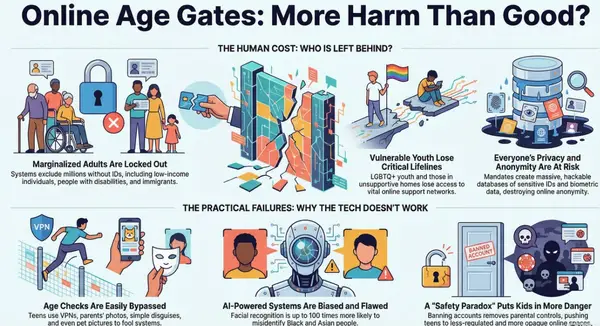Nepal Social Media Ban: Critical Compliance Lessons for Global Technology Companies

Nepal's September 2025 ban of 26 major social media platforms serves as a stark wake-up call for technology companies operating globally. The sudden shutdown of Facebook, Instagram, YouTube, X, and other platforms demonstrates how quickly regulatory non-compliance can escalate from warnings to complete market exclusion. For compliance professionals and technology companies, Nepal's actions provide crucial insights into emerging regulatory expectations and the real-world consequences of inadequate local compliance strategies.
Executive Summary: When Compliance Failures Go Critical
On September 5, 2025, Nepal's government implemented one of the most comprehensive social media bans in recent history, blocking 26 platforms after they failed to meet local registration requirements. This wasn't a sudden decision—companies had received multiple warnings and a final seven-day ultimatum starting August 28, 2025.
The compliance failure was complete: Only TikTok, Viber, and three smaller platforms had successfully registered and continued operations. Major global platforms including Meta's properties (Facebook, Instagram, WhatsApp), Google's YouTube, and X failed to establish the required local presence.
Key Compliance Takeaway: Even global technology giants are not immune to regulatory enforcement. Local compliance requirements, regardless of company size or global influence, must be treated as mandatory business requirements, not optional considerations.

Regulatory Requirements: What Companies Failed to Implement
Registration and Local Presence Requirements
Nepal's "Directive for Regulation of Social Media Use, 2080" mandated that all social media platforms:
- Register with the Ministry of Communication and Information Technology
- Establish a local office or representative in Nepal
- Appoint a designated contact person for regulatory communications
- Designate a grievance handler for user complaints
- Assign a compliance officer responsible for self-regulation
- Secure operating licenses within three months of registration
- Renew licenses every three years
Compliance Timeline and Enforcement
- Initial Warning Period: Multiple diplomatic and official requests over several months
- Cabinet Decision: Formal deadline established in late August 2025
- Final Ultimatum: Seven-day notice issued August 28, 2025
- Enforcement: Immediate blocking began September 5, 2025
Compliance Lesson: Regulatory patience has limits. The progression from diplomatic requests to enforcement action demonstrates that governments will eventually act decisively when voluntary compliance fails.
The High Cost of Non-Compliance
Immediate Business Impact
The ban's financial consequences were severe and immediate:
- Complete market access loss for platforms serving millions of users
- Revenue disruption in a market where social media accounts for 80% of internet traffic
- Customer relationship damage affecting 13.5 million Facebook users, 10.85 million Messenger users, and millions of others
- Reputational harm in neighboring markets watching Nepal's enforcement actions
Operational Consequences
Non-compliant platforms faced:
- Immediate service blocking through DNS and IP address restrictions
- No grandfathering of existing user relationships or business operations
- Uncertain restoration timeline dependent on future compliance efforts
- Lost competitive positioning to compliant platforms like TikTok and Viber
Compliance Insight: Modern regulatory enforcement can eliminate market access instantly. Traditional grace periods and gradual enforcement are becoming less common as governments develop sophisticated technical enforcement capabilities.
Nepal's Broader Regulatory Environment: A Compliance Risk Assessment
Cybersecurity Compliance Challenges
Nepal's regulatory action stems from broader cybersecurity concerns that compliance teams must understand:
Threat Landscape Statistics:
- 4,937 cybercrime cases registered between September 2022-April 2023
- 340% annual growth in hacking incidents
- 16,190 total complaints since 2020
- 60-70 daily cybercrime complaints to authorities
Infrastructure Vulnerabilities:
- Over 80% of Nepal's websites vulnerable to cyber attacks
- Government websites frequently targeted (1,500 sites compromised in January 2025)
- Centralized hosting infrastructure creating systemic risks
Legal and Regulatory Framework
Constitutional Foundation: Article 28 of Nepal's Constitution guarantees privacy rights, creating the legal basis for data protection enforcement.
Key Compliance Laws:
- Electronic Transactions Act, 2063 (2006) - Core cybersecurity framework
- Individual Privacy Act, 2075 (2018) - Personal data protection requirements
- Data Protection Act, 2079 (2022) - Comprehensive data governance framework
- National Cyber Security Policy, 2080 (2023) - Strategic cybersecurity direction
Enforcement Capabilities
Nepal has developed significant enforcement infrastructure:
- Nepal Telecommunications Authority (NTA) - Technical implementation of blocks
- Cyber Bureau of Nepal Police - Criminal enforcement and investigation
- Ministry of Communication and Information Technology - Regulatory oversight
- Proposed Computer Emergency Response Team (CERT) - Incident response and coordination
International Compliance Trends: Nepal in Global Context
Regulatory Convergence
Nepal's actions reflect global regulatory trends that compliance teams must monitor:
Similar Requirements Worldwide:
- European Union: Digital Services Act requiring local representation
- India: Information Technology Rules mandating grievance officers
- Australia: Online Safety Act establishing local compliance obligations
- Brazil: Marco Civil da Internet requiring local data processing
- United States: Various state-level requirements for platform operations
Common Compliance Elements:
- Local representation requirements
- Content moderation obligations
- Data localization mandates
- Transparency reporting requirements
- User grievance mechanisms
- Government cooperation protocols
Enforcement Pattern Analysis
Escalation Typically Follows This Pattern:
- Informal diplomatic requests through embassies or trade channels
- Formal regulatory notices with specific compliance requirements
- Public deadlines creating political pressure for action
- Technical enforcement through ISP blocking or other measures
- Economic sanctions including fines or market access restrictions
Nepal's Compliance Lesson: This escalation pattern is becoming standard globally. Companies cannot assume that informal resistance or delay tactics will prevent enforcement.
Compliance Strategy Recommendations
Immediate Action Items for Technology Companies
1. Regulatory Mapping and Monitoring
- Establish systematic monitoring of local registration requirements in all operational jurisdictions
- Create compliance calendars tracking regulatory deadlines and renewal requirements
- Implement early warning systems for new regulatory proposals
2. Local Presence Strategy
- Develop standardized approaches for establishing local representation
- Create templates for appointing local grievance officers and compliance personnel
- Establish protocols for rapid compliance implementation when required
3. Government Relations Framework
- Maintain regular dialogue with telecommunications and technology regulators
- Participate in industry associations and regulatory consultations
- Build relationships before compliance crises emerge
Long-Term Compliance Architecture
Proactive Compliance Framework:
Risk Assessment: Regular evaluation of regulatory environments in all operational markets, with particular attention to:
- Countries with growing cybersecurity concerns
- Markets with recent data localization trends
- Jurisdictions with expanding platform regulation
Compliance Infrastructure: Standardized systems for:
- Local representative appointment and management
- Grievance handling and user complaint resolution
- Regulatory reporting and transparency obligations
- Content moderation and takedown procedures
Legal and Technical Readiness: Preparation for:
- Data localization requirements
- Platform registration and licensing
- Local content storage and processing
- Government information requests
Industry-Specific Considerations
Social Media Platforms: Must prepare for content moderation requirements, local grievance mechanisms, and government takedown request procedures.
Cloud Service Providers: Should anticipate data localization mandates and local processing requirements.
E-commerce Platforms: Need frameworks for local tax compliance, consumer protection, and dispute resolution.
Financial Technology: Must prepare for enhanced due diligence, local licensing, and anti-money laundering compliance.
The Business Case for Proactive Compliance
Cost-Benefit Analysis
Compliance Investment vs. Non-Compliance Risk:
Proactive Compliance Costs:
- Local representative fees: $50,000-200,000 annually per jurisdiction
- Legal and regulatory consulting: $100,000-500,000 annually
- Compliance system development: $200,000-1,000,000 one-time investment
- Ongoing monitoring and reporting: $50,000-300,000 annually
Non-Compliance Risk Exposure:
- Complete market access loss (potentially millions in revenue)
- Emergency compliance costs (typically 3-5x proactive investment)
- Reputational damage and competitive disadvantage
- Regulatory scrutiny in other jurisdictions
Strategic Advantages of Compliance Leadership
Market Access: Compliant companies maintain uninterrupted service and competitive advantage when enforcement actions occur.
Regulatory Relationships: Proactive compliance builds positive relationships with regulators, potentially influencing future policy development.
Operational Efficiency: Standardized compliance frameworks reduce complexity and costs across multiple jurisdictions.
Risk Management: Systematic compliance reduces exposure to sudden regulatory changes and enforcement actions.
Future Regulatory Landscape: What Compliance Teams Should Expect
Emerging Trends
1. Accelerated Enforcement: Governments are developing faster, more decisive enforcement capabilities.
2. Technical Sophistication: Regulatory agencies increasingly use automated blocking and monitoring systems.
3. International Coordination: Cross-border regulatory cooperation is making non-compliance more difficult to sustain.
4. User Protection Focus: Growing emphasis on user safety, data protection, and platform accountability.
Preparation Strategies
Regulatory Intelligence: Establish systematic monitoring of regulatory developments across all operational jurisdictions.
Compliance Automation: Invest in systems that can rapidly implement compliance requirements across multiple markets.
Stakeholder Engagement: Build relationships with regulators, industry associations, and policy organizations.
Crisis Management: Develop protocols for rapid response to regulatory enforcement actions.
Conclusion: Nepal as a Compliance Wake-Up Call
Nepal's social media ban demonstrates that regulatory compliance is no longer optional for global technology companies. The days when platforms could operate with minimal local compliance infrastructure are ending. Governments worldwide are developing both the legal frameworks and technical capabilities to enforce local requirements decisively.
Key Compliance Lessons:
- Scale Provides No Immunity: Even the world's largest technology companies face complete market exclusion for non-compliance.
- Local Requirements Are Mandatory: Global companies must adapt to local regulatory frameworks, regardless of their global policies or practices.
- Enforcement Is Accelerating: The timeline from warning to enforcement is shortening as governments develop more sophisticated capabilities.
- Proactive Compliance Is Cost-Effective: The investment in proactive compliance is minimal compared to the risks of enforcement action.
For compliance professionals, Nepal's actions should serve as a catalyst for comprehensive review of global compliance strategies. Companies that treat local regulatory requirements as optional business considerations do so at their own peril. The future belongs to organizations that build compliance into their global operating model from the outset, rather than those that attempt to manage regulatory relationships reactively.
The Nepal ban is not an isolated incident—it's a preview of the global regulatory environment that technology companies must navigate. Success in this environment requires treating compliance not as a cost center, but as a strategic capability that enables sustainable global operations.
For compliance professionals seeking to understand the full implications of Nepal's regulatory actions and develop appropriate response strategies, the key is to view this not as a Nepal-specific issue, but as part of a global trend toward more assertive technology regulation that demands equally sophisticated compliance responses.






